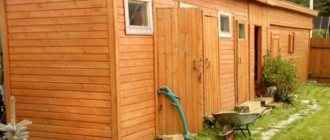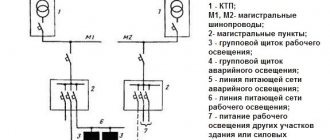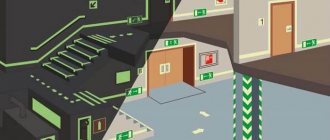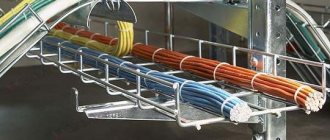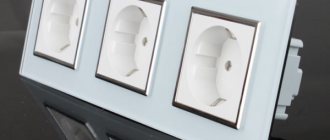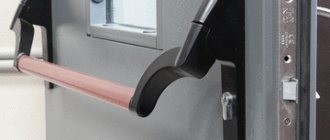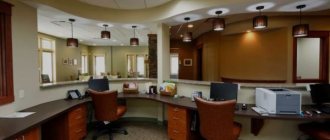Light sources, installation of lighting fixtures and supports
6.3.1.
Any light sources can be used for outdoor lighting (see clause 6.1.11). For security lighting of enterprise territories, the use of discharge lamps is not allowed in cases where security lighting is not normally turned on and turns on automatically due to the operation of a security alarm.
6.3.2. Outdoor lighting devices (lamps, spotlights) can be installed on supports specially designed for such lighting, as well as on overhead line supports up to 1 kV, contact network supports for electrified urban transport of all types of currents with voltage up to 600 V, walls and ceilings of buildings and structures, masts (including masts of free-standing lightning rods), technological overpasses, platforms of technological installations and chimneys, parapets and fences of bridges and transport overpasses, on metal, reinforced concrete and other structures of buildings and structures, regardless of the mark of their location, can be suspended on cables , mounted on the walls of buildings and supports, and also installed at ground level and below.
6.3.3. Installation of outdoor lighting fixtures on overhead line supports up to 1 kV should be carried out:
1. When servicing lamps from a telescopic tower with an insulating link, as a rule, above the overhead line wires or at the level of the lower overhead line wires when placing the lamps and overhead line wires on different sides of the support. The horizontal distance from the lamp to the nearest overhead line wire must be at least 0.6 m.
2. When servicing lamps by other means, below the overhead line wires. The vertical distance from the lamp to the overhead line wire (clear) must be at least 0.2 m, the horizontal distance from the lamp to the support (clear) must be no more than 0.4 m.
6.3.4. When hanging luminaires on cables, measures must be taken to prevent the luminaires from swinging due to wind.
6.3.5. Above the carriageway of streets, roads and squares, lamps must be installed at a height of at least 6.5 m.
When installing lamps above the tram contact network, the installation height of the lamps must be at least 8 m to the rail head. When luminaires are located above the trolleybus contact network - at least 9 m from the level of the roadway. The vertical distance from the wires of street lighting lines to the crossbars of the contact network or to the illumination garlands suspended from the crossbars must be at least 0.5 m.
6.3.6. Above boulevards and pedestrian roads, lamps must be installed at a height of at least 3 m.
The minimum installation height of lighting fixtures for lighting lawns and facades of buildings and structures and for decorative lighting is not limited, provided that the requirements of clause 6.1.15 are met.
Installation of lighting fixtures in pits below ground level is permitted if there are drainage or other similar devices for removing water from the pits.
6.3.7. To illuminate transport intersections, city and other areas, lamps can be installed on supports with a height of 20 m or more, provided that the safety of their maintenance is ensured (for example, lowering lamps, constructing platforms, using towers, etc.).
It is allowed to place lamps in parapets and fences of bridges and overpasses made of non-combustible materials at a height of 0.9-1.3 m above the roadway, provided they are protected from touching the live parts of the lamps.
6.3.8. The supports of lighting installations for squares, streets, and roads must be located at a distance of at least 1 m from the front edge of the side stone to the outer surface of the support base on main streets and roads with heavy traffic and at least 0.6 m on other streets, roads and squares. This distance is allowed to be reduced to 0.3 m, provided there are no public transport routes or trucks. If there is no side stone, the distance from the edge of the roadway to the outer surface of the support base must be at least 1.75 m.
In the territories of industrial enterprises, the distance from the external lighting support to the roadway is recommended to be at least 1 m. This distance can be reduced to 0.6 m.
6.3.9. Lighting poles for streets and roads with dividing strips 4 m wide or more can be installed in the center of the dividing strips.
6.3.10. On streets and roads with ditches, it is allowed to install supports behind the ditch if the distance from the support to the nearest border of the roadway does not exceed 4 m.
The support should not be between the fire hydrant and the roadway.
6.3.11. It is recommended to install supports at intersections and junctions of streets and roads at a distance of at least 1.5 m from the beginning of the curvature of sidewalks, without disturbing the line of installation of supports.
6.3.12. External lighting supports on engineering structures (bridges, overpasses, transport overpasses, etc.) should be installed in the alignment of fences in steel frames or on flanges attached to the load-bearing elements of the engineering structure.
6.3.13. Supports for lighting fixtures for alleys and pedestrian roads should be located outside the pedestrian area.
6.3.14. Lamps on streets and roads with row planting of trees should be installed outside the tree crowns on elongated brackets facing the roadway, or cable suspension of the lamps should be used.
Lighting
6.6.1. Lighting devices must be installed so that they are accessible for their installation and safe maintenance using, if necessary, inventory technical means.
In production facilities equipped with overhead cranes involved in the continuous production process, as well as in craneless spans in which access to lamps using floor and other mobile means is impossible or difficult, the installation of lamps and other equipment and the laying of electrical networks can be carried out on special stationary bridges made of non-combustible materials. The width of the bridges must be at least 0.6 m, they must have fences at least 1 m high.
In public buildings, the construction of such bridges is allowed if it is not possible to use other means and methods of access to the lamps.
6.6.2. Lamps served from stepladders or ladders must be installed at a height of no more than 5 m (to the bottom of the luminaire) above the floor level. At the same time, the placement of lamps above large equipment, pits and in other places where it is impossible to install ladders or stepladders is not allowed.
6.6.3. Lamps used in installations subject to vibrations and shocks must be designed to prevent the lamps from unscrewing or falling out. It is allowed to install luminaires using shock-absorbing devices.
6.6.4. For pendant lamps for general lighting, it is recommended to have overhangs no longer than 1.5 m. For longer overhangs, measures must be taken to limit the swing of the lamps under the influence of air currents.
6.6.5. In hazardous areas, all permanently installed lighting fixtures must be rigidly reinforced to prevent swinging.
When using slotted optical fibers in hazardous areas, the requirements of Chap. 7.3.
For premises classified as fire hazardous zones P-IIa, lamps with non-flammable lenses in the form of solid silicate glass must be used.
6.6.6. To ensure the possibility of servicing lighting devices, it is allowed to install them on rotating devices, provided that they are rigidly attached to these devices and power is supplied via a flexible cable with copper conductors.
6.6.7. To illuminate transport tunnels in cities and on highways, it is recommended to use lamps with a degree of protection IP65.
6.6.8. Local lighting luminaires must be fixed rigidly or so that after moving they stably maintain their position.
6.6.9. Devices for hanging lamps must withstand for 10 minutes without damage or residual deformation a load applied to them equal to five times the mass of the lamp, and for complex multi-lamp chandeliers weighing 25 kg or more - a load equal to twice the mass of the chandelier plus 80 kg.
6.6.10. For permanently installed luminaires, screw current-carrying sleeves of sockets for lamps with screw bases in networks with a grounded neutral must be connected to the neutral working conductor.
If the cartridge has a non-current-carrying screw sleeve, the neutral working conductor must be connected to the contact of the cartridge to which the screw base of the lamp is connected.
6.6.11. In store windows, it is allowed to use sockets with incandescent lamps with a power of no more than 100 W, provided they are installed on non-combustible bases. It is allowed to install cartridges on flammable, for example wooden, bases sheathed with sheet steel over asbestos.
6.6.12. Wires must be inserted into the lighting fixtures in such a way that they are not subject to mechanical damage at the point of entry, and the cartridge contacts are relieved from mechanical stress.
6.6.13. Connecting wires inside brackets, hangers or pipes with which lighting fixtures are installed is not allowed. Wire connections should be made in places accessible to control, for example, at the bases of brackets, at the points where wires enter lamps.
6.6.14. Lighting fixtures may be suspended on supply wires if they are intended for this purpose and are manufactured according to special technical conditions.
6.6.15. General lighting fixtures that have terminal clamps for connecting supply conductors must allow the connection of wires and cables with both copper and aluminum conductors.
For lighting fixtures that do not have terminal clamps, when the conductors inserted into the fixture are directly connected to the contact clamps of lamp sockets, wires or cables with copper conductors with a cross-section of at least 0.5 mm2 inside buildings and 1 mm2 outside buildings must be used. At the same time, in the fittings for incandescent lamps with a power of 100 W and higher, DRL, DRI, DRIZ, DNAT lamps, wires with insulation that allows their heating temperature of at least 100 ° C must be used.
Unprotected wires inserted into freely suspended luminaires must have copper conductors.
Wires laid inside the lighting fixtures must have insulation corresponding to the rated voltage of the network (see also clause 6.3.34).
6.6.16. Branches from distribution networks to outdoor lighting fixtures must be made with flexible wires with copper conductors with a cross-section of at least 1.5 mm2 for pendant lamps and at least 1 mm2 for cantilever lamps. It is recommended to make branches from overhead lines using special adapter branch clamps.
6.6.17. To connect tabletop, portable and hand-held lamps to the network, as well as local lighting lamps suspended on wires, cords and wires with flexible copper conductors with a cross-section of at least 0.75 mm2 must be used.
6.6.18. To charge stationary local lighting fixtures, flexible wires with copper conductors with a cross-section of at least 1 mm2 for movable structures and at least 0.5 mm2 for fixed structures must be used.
The insulation of the wires must correspond to the rated voltage of the network.
6.6.19. Charging brackets for local lighting fixtures must meet the following requirements:
- The wires must be led inside the bracket or otherwise protected from mechanical damage; at a voltage not higher than 50 V, this requirement is not mandatory.
- If there are hinges, the wires inside the hinged parts must not be subject to tension or chafing.
- The holes for wires in the brackets must have a diameter of at least 8 mm with the allowance of local narrowings of up to 6 mm; Insulating bushings must be used at wire entry points.
- In movable structures of lighting fixtures, the possibility of spontaneous movement or swinging of the fixtures must be excluded.
6.6.20. The connection of the floodlights to the network must be carried out using a flexible cable with copper conductors with a cross-section of at least 1 mm2 and a length of at least 1.5 m. The protective grounding of the floodlights must be carried out with a separate conductor.
Power supply for outdoor lighting installations
6.3.15. Outdoor lighting installations can be powered directly from transformer substations, distribution points and input distribution devices (IDUs).
6.3.16. To power street lighting fixtures, as well as outdoor lighting of industrial enterprises, as a rule, independent lines must be laid.
The luminaires may be powered from additionally laid phase and common neutral wires of the overhead electrical network of a city, populated area, or industrial enterprise.
6.3.17. Lighting installations of urban transport and pedestrian tunnels, lighting installations of streets, roads and squares of category A in terms of reliability of power supply belong to the second category, the rest of the external lighting installations - to the third category.
6.3.18. Power supply for lighting fixtures in neighborhoods should be carried out directly from outdoor lighting power points or from street lighting networks running nearby (excluding category A street networks), depending on the operating system adopted in the locality. Lamps for external lighting of the territories of kindergartens, secondary schools, boarding schools, hospitals, hospitals, sanatoriums, boarding houses, holiday homes, pioneer camps can be powered both from the input devices of these buildings or transformer substations, and from the nearest outdoor lighting distribution networks, provided compliance with the requirements of clause 6.5.27.
6.3.19. Lighting of open technological installations, open work sites, open overpasses, warehouses and other open objects in industrial buildings can be powered from the internal lighting networks of the buildings to which these objects belong.
6.3.20. It is recommended to power security lighting, as a rule, through independent lines.
6.3.21. Power supply for lighting devices at entrances to fire-fighting water sources (hydrants, reservoirs, etc.) should be carried out from the night mode phases of the outdoor lighting network.
6.3.22. It is recommended to connect luminaires installed at the entrances to buildings to a group network of internal lighting and, first of all, to a network of security lighting or evacuation lighting, which are turned on simultaneously with working lighting.
6.3.23. In outdoor lighting installations, luminaires with discharge sources must have individual reactive power compensation. The power factor must be at least 0.85.
6.3.24. When using floodlights with discharge light sources, group compensation of reactive power is allowed.
With group compensation, it is necessary to ensure that the compensating devices are turned off simultaneously with the installations they compensate for.

